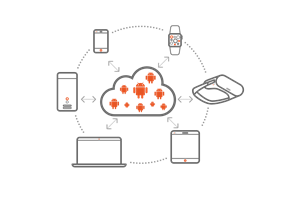Mobility is now vital for any enterprise looking to stay competitive. For many organisations, enterprise mobile applications are a key factor for success. Today’s companies, says Stephan Fabel, director of product at Canonical, especially those with field and remote workforces, rely on a large number of enterprise mobile applications to ensure employees remain productive and business operations running smoothly.
There are many industry examples of businesses who have workers in the field – manufacturing, retail, logistics, transportation, and healthcare are just a few. While mobile workforces are no longer a new idea, advances in connectivity and cloud computing have contributed to a boom in mobile and remote workers.
Employees in these sectors are increasingly using mobile applications on smartphones and tablets to carry out day-to-day operations. A significant proportion of these applications are Android-based. Android remains the operating system of choice for enterprises, with its wide 2.9 million application ecosystem and mobile market share.
Importance of user experience
User experience remains a really important factor for enterprises and app developers developing applications to be used by employees. However, the challenge for many is that they need to be able to securely and cost-effectively distribute and manage mobile applications in a consistent manner across a fleet of devices, and at the same time have the ability to flexibly scale based on demand.

So how can enterprises overcome this delivery issue? Businesses who are undergoing digital transformation are increasingly turning to containerisation in the cloud to deliver mobile applications on smartphones or tablets to their mobile workforce. A dedicated mobile cloud computing platform which can run containerised Android application workloads in the cloud enables businesses to develop, trial and experiment and provide an on-demand application experience on any device or operating system, while taking advantage of the compute and storage that cloud provides. This process is particularly useful for high energy and more advanced applications such as AR/VR and wearables.
During internal application development, harnessing a platform for virtualising mobile workloads significantly reduces engineering costs and complexities by allowing for development of a single application that can be used across different form factors and operating systems. At the same, for mobile app developers with CI/CD pipelines who are running containerisation application workloads in the cloud, containerisation makes it possible to simulate multiple Android devices across different test scenarios.
Crucial scalability
Once at the deployment stage, scalability becomes crucial. Containerisation via the cloud enables the distribution of mobile applications to any number of devices, without the need to download the application locally. For instance, let’s take a warehouse scenario where employees use devices to scan items within a product line. Rather than buying hundreds of scanning devices, the scanning application can be accessed from any device – no matter its form factor – via the cloud, reducing the CAPEX of equipment investment and the OPEX of maintenance.
This process also offers an array of hosting options, depending on both the organisation and its workforce’s requirements. Hosting these containerised applications in the public cloud provides increased storage capacity and agility. While the option of hosting on a private cloud edge reduces latency, and increases data privacy, especially important for enterprises which require high levels of security.
The healthcare sector is an industry example that is seeing an increase in mobile health workers using mobile applications to assist them with patient care away from centralised locations like hospitals and closer to patients in the community. By utilising a platform which enables Android application containerisation in the cloud, healthcare trusts can empower their workers to log onto an app from any device. This removes the need for sharing devices from shift-to-shift and reduces the risk of unsolicited access to sensitive information, at the same time using the security of the cloud to keep patient data safe.
Mainstream technologies
5G and cloud are key drivers for this trend and as both become part of mainstream business technology, we’ll see more applications processing and delivering larger datasets, and more companies turning to applications as they undergo digital transformation. For those who need more control over performance, better cost-efficiency, and increased security and scalability, containerising applications in the cloud offers a reliable solution.
The author is Stephan Fabel, director of product at Canonical.
Comment on this article below or via Twitter: @VanillaPlus OR @jcvplu






